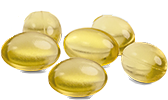Omega 3 fatty acids are essential, which means just like vitamins, we cannot produce them ourselves. If we opt out of fish in our diets, it is, therefore, necessary to get these fatty acids in other ways such as from algae or seed oils.
About the algae oil
The microalgae Schizochytrium is a single-celled alga that feeds on organic matter from fallen leaves in coastal areas of the tropics. The algae, which originates in mangrove forests, do not require light. The algae are able to produce the omega-3 fatty acids EPA and DHA from the plant matter that they convert.
The algae oil provides the same health benefits as fish oil. The EPA and DHA found in fish are accumulated from the algae that the fish have eaten.
The algae oil is produced in the EU. It is non-GMO, gluten-free, and non-allergenic. It is extracted by means of fermentation followed by extraction without the use of solvents, after which the oil is purified. This process takes place in an environmentally friendly process.
To limit the risk of oxidation, the oil goes through a patented process that preserves the oil's nutritional properties, taste, smell, colour, and appearance. The patented technology includes an exclusive mixture of antioxidants that work synergistically.
This technology guarantees an ultra-stable oil that preserves the nutritional value of the oil without the taste of fish and without fish burps.
About the Chia oil
Chia oil is produced by the mechanical pressing of oily Chia seeds. The chia plant, which is called Salvia hispanica in Latin, belongs to the mint family and originates originally from southern Mexico and northern Guatemala. Under optimal conditions, it can grow well over a meter high. The plant has violet-white flowers, and its small, oval, grey-brown seeds are high in fatty acids. The oil's content of the omega 3 fatty acid alpha-linolenic acid (ALA) is over 60%.
Due to the high fatty acid content, the extraction of the oil requires no solvents. The oil is therefore cold-pressed and subsequently filtered to remove impurities.
The body has some capacity to convert ALA into the fatty acids eicosapentaenoic acid (EPA) and docosahexaenoic acid (DHA) using enzymes.






